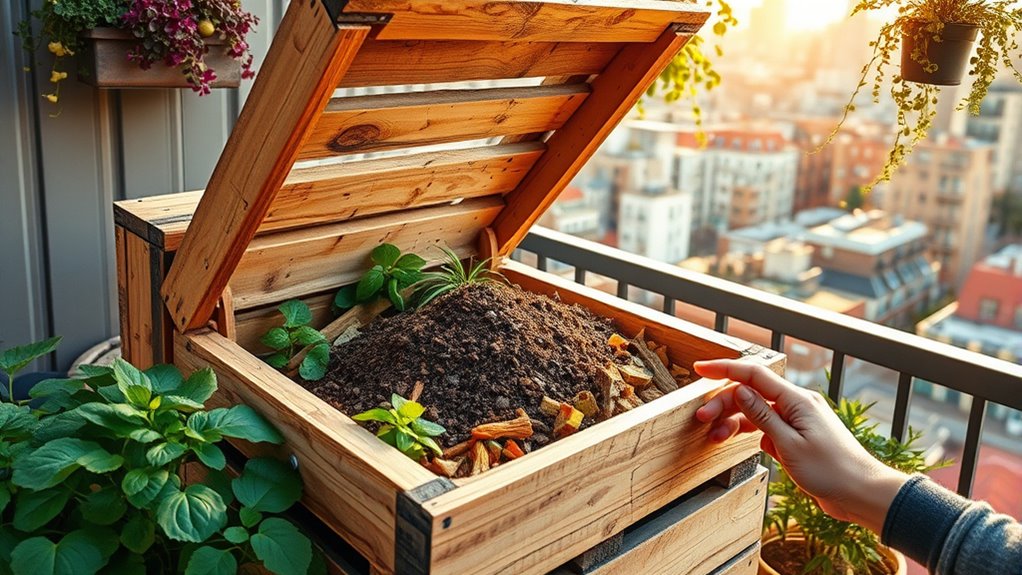Starting a DIY compost bin in the city is simple and eco-friendly. Choose a bin suitable for your space, like a tumbler, stationary, or repurposed container, with good airflow and drainage. Fill it with kitchen scraps (greens) and yard waste (browns), maintaining a 2:1 ratio. Turn it weekly to aerate and keep it moist. When the compost turns dark, crumbly, and earthy-smelling, you’re ready to use it. Keep exploring to learn how to perfect your composting process.
Key Takeaways
- Choose a compact, well-ventilated compost bin suitable for small spaces like balconies or patios.
- Collect green kitchen scraps and brown yard waste, maintaining a 2:1 brown-to-green ratio for efficient composting.
- Regularly turn and moisten the compost to aerate microbes and prevent odors, ensuring proper decomposition.
- Use signs such as dark color, earthy smell, and crumbly texture to identify when compost is ready for use.
- Benefits include reducing waste, enriching soil, and supporting sustainable gardening in limited urban spaces.

Ever wondered how to turn your kitchen scraps and yard waste into nutrient-rich soil? Composting is a simple, eco-friendly way to recycle your organic waste while improving your soil health. Even if you live in the city with limited space, you can create a thriving compost system that benefits your plants and the environment. The key is understanding the right compost bin materials and how they work together to foster healthy decomposition.
Start by choosing a suitable compost bin that fits your space and needs. You can opt for a traditional tumbling bin, a stationary container, or even a DIY setup made from repurposed materials. Whatever you choose, ensure it has proper ventilation and drainage to promote airflow and prevent odors. The materials you use for your compost bin will influence how efficiently your compost breaks down, so pick sturdy, non-toxic options like wood, plastic, or wire mesh. Avoid treated lumber or painted surfaces that could leach chemicals into your compost.
Choose a compost bin with proper ventilation and drainage for efficient, odor-free decomposition.
As you gather your kitchen scraps and yard waste, focus on balancing green and brown materials. Green materials include fruit and vegetable peels, coffee grounds, and fresh grass clippings—rich in nitrogen and essential for microbial activity. Brown materials, like dry leaves, shredded paper, and cardboard, supply carbon, which helps structure the compost and prevent it from becoming too wet or slimy. When layering these materials in your compost bin, aim for a ratio of roughly 2 parts brown to 1 part green to maintain ideal soil health and promote efficient decomposition.
Make sure to turn your compost regularly, about once a week, to aerate the mixture and speed up the process. Turning introduces oxygen to the microbes doing the work, which is essential for breaking down organic matter into nutrient-rich humus. Keep your compost moist but not soaked—think of a wrung-out sponge—since moisture is crucial for microbial activity but excess water can lead to anaerobic conditions and smell issues. Incorporating proper contrast ratio management can also help control odor and ensure vibrant decomposition.
As the compost matures, it will darken, smell earthy, and be crumbly to the touch. This is a sign that your soil is enriched and ready to be used in your garden or containers. By paying attention to soil health and choosing the right compost bin materials, you’re creating a sustainable cycle that reduces waste and nurtures your plants. Even in a small city backyard or balcony, your efforts can make a significant difference—turning everyday waste into the foundation for vibrant, healthy soil.
Frequently Asked Questions
How Often Should I Turn My Compost?
You should turn your compost every 1 to 3 days to maintain ideal soil moisture and keep it aerated. Regular turning helps regulate compost temperature, preventing it from overheating or becoming too cold. By doing this, you guarantee microbes stay active, breaking down materials efficiently. Keep an eye on soil moisture levels and adjust your turning frequency if it gets too dry or too wet, promoting healthy composting.
Can I Compost Meat and Dairy?
You can compost meat and dairy, but it’s not always ideal, especially in small city compost bins. Meat composting and dairy disposal can attract pests and cause odors, making your compost less manageable. If you choose to include these, bury them deep in the pile and balance with plenty of brown materials. Consider using a compost bin designed for meat composting to minimize problems and keep your city composting efforts eco-friendly.
What’S the Ideal Compost Bin Size for Small Spaces?
Think of your compost bin as a tiny urban garden sanctuary. For small spaces, a compact bin—about 3 to 5 gallons—works best, fitting snugly in your balcony or kitchen corner. Choose durable compost bin materials like plastic or metal that resist weather and pests. This size balances ease of use with enough capacity for your city gardening needs, making composting manageable without cluttering your space.
How Long Does It Take for Compost to Be Ready?
You might wonder how long it takes for compost to be ready. Typically, the composting timeline varies based on factors like temperature, materials, and aeration, but you can expect compost maturity within 3 to 6 months. By regularly turning and maintaining your compost, you speed up the process, ensuring your compost reaches maturity sooner. Patience is key, but consistent care makes the wait worthwhile.
How Do I Prevent Pests in My Compost Bin?
To prevent pests in your compost bin, you should use effective pest deterrent strategies like covering food scraps with brown materials and avoiding meat or dairy. Implement safe composting practices by securing the lid tightly and turning the compost regularly. Keep the bin in a dry, well-ventilated spot, and avoid adding spoiled or greasy waste. These steps help maintain a pest-free compost and promote healthy decomposition.
Conclusion
As you start composting, it’s almost poetic how your kitchen scraps transform into rich soil just as life in the city continues to bustle around you. The coincidence of turning waste into nourishment reminds you that small actions have a bigger impact. With patience and care, you’ll find that your urban space becomes more sustainable, proving that even in the busiest places, nature’s cycle can thrive—sometimes, all it takes is a little compost to make it happen.









